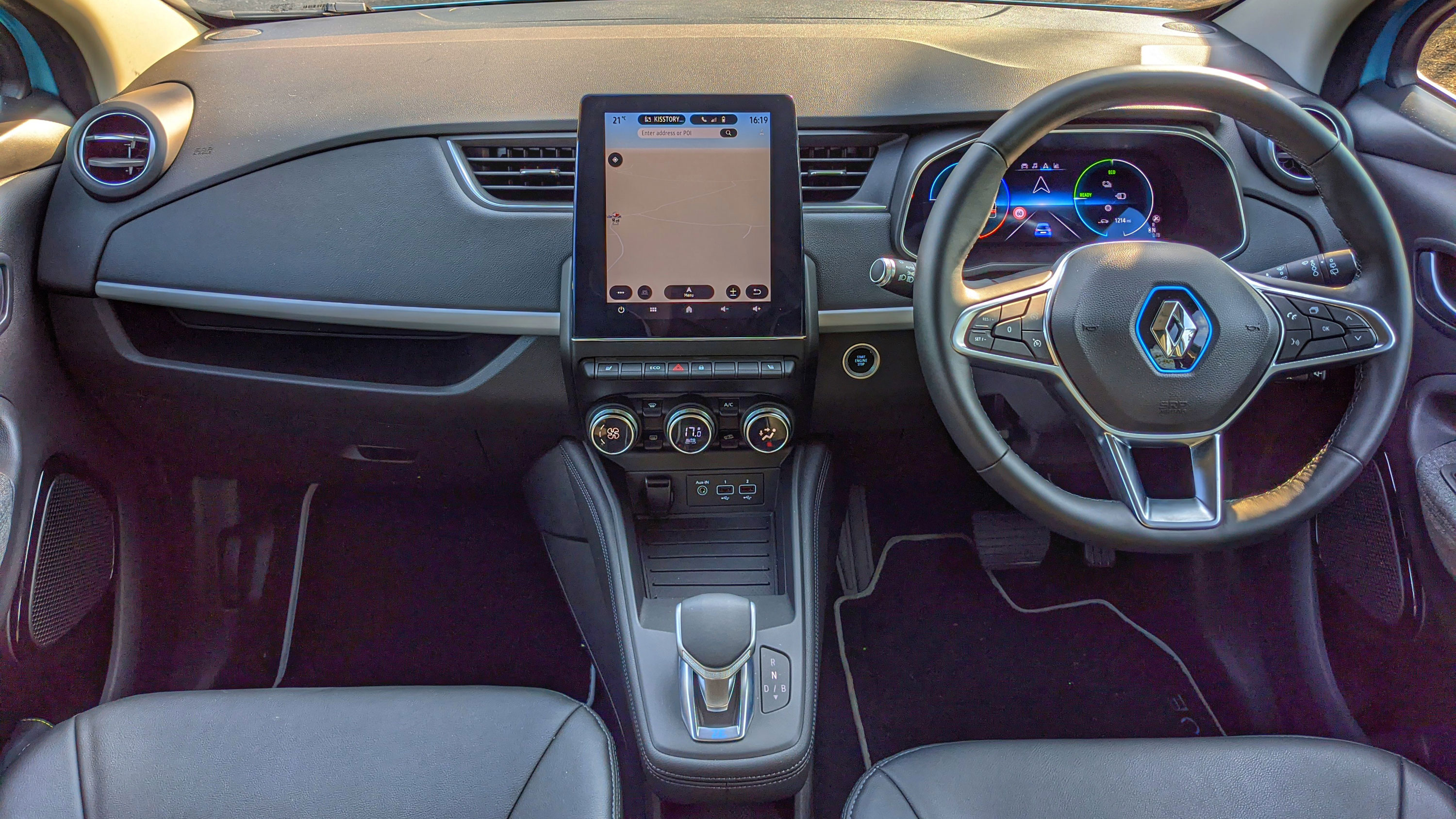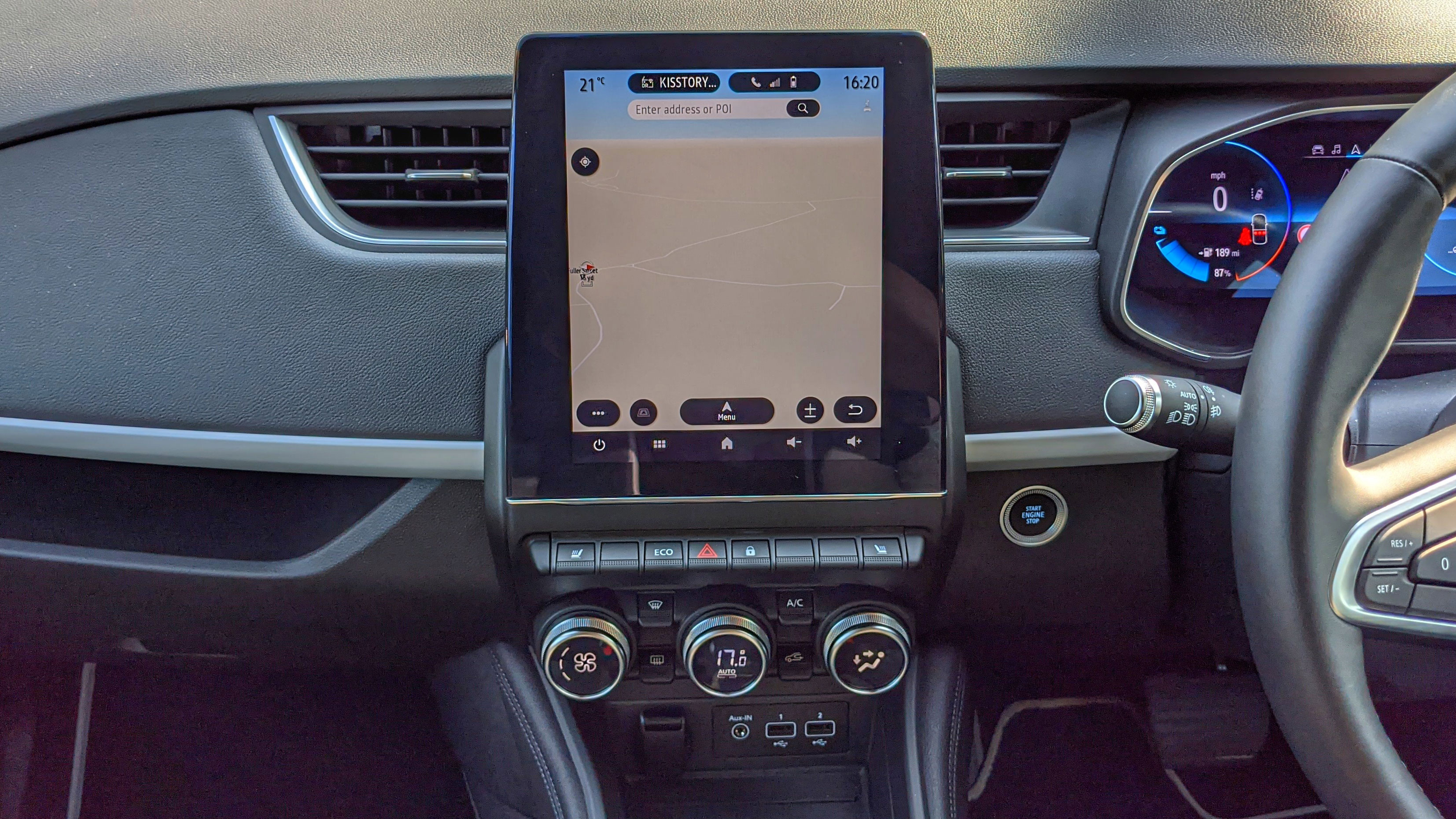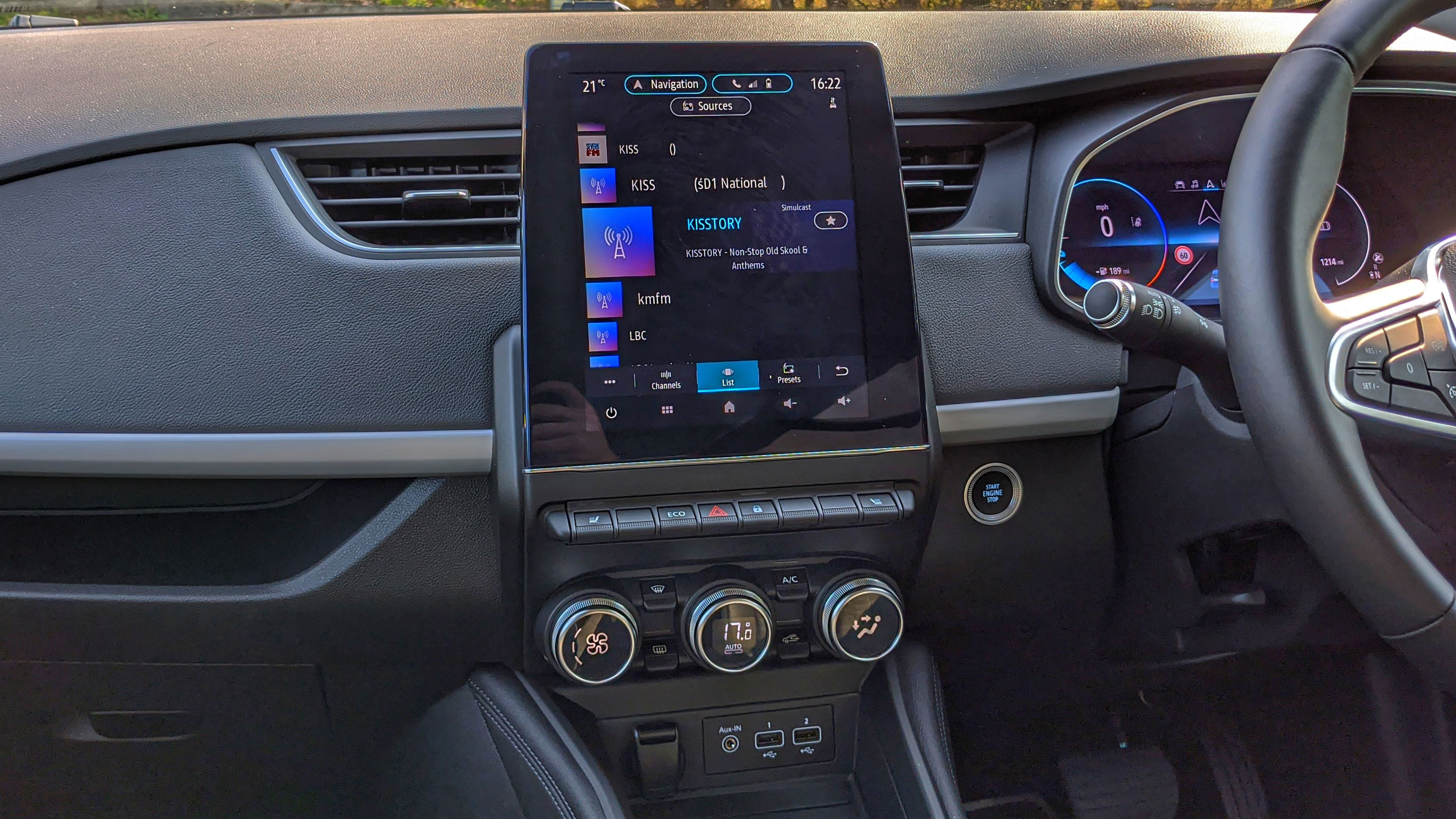The Renault Zoe is an electric car made for the city - compact, agile and packing enough tech to make driving a breeze.
Not only does it offer the likes of cruise control, a reversing camera and a large touchscreen display, the Zoe is also compatible with Renault's smartphone app and comes with a range-saving Eco mode.
Starting at £26,495 (after the £3,000 plug-in car grant), the Renault Zoe is one of the cheaper electric car options on the market, however we drove the top of the range Zoe GT Line which had an on the road price of £30,120.
- Hyundai Kona Electric: all-electric SUV has tech and plenty of range
- Audi e-tron: driving the first all-electric Audi
- Kia e-Niro: the EV for the people
Renault Zoe design
We drove
Renault Zoe GT Line
Power: 134bhp
Top Speed: 87mph
0-62mph: 9.5 seconds
Range: 238 miles
Price: £30,120
The Renault Zoe looks and feels like a slightly raised Renault Clio, and its proportions - and humble boot space - are reminiscent of the now defunct Renault Modus, albeit with more modern styling.
The Celadon Blue paint finish (an additional cost) of our GT Line Rapid Charge model is pleasing to the eye, and overall the Zoe has a cutesy look to it.
It's a five-door car, although at first glance you may be mistaken for thinking it's a three-door offering, as the door handles for the rear doors are mounted into the bezel by the window frame, hiding them from the contours of the car.
They're relatively easy to use, as you push a finger on the embossed fingerprint logo on the plastic to pop the handle out, and then pull it fully to open the door. It's not as slick as a traditional handle, but it has allowed Renault to create a more seamless design.
Move yourself into the driving seat and you'll find it has an elevated position (again, like the Modus), giving you a more SUV-like view of the road (although you're not as high as most SUVs). This helps with visibility, which is always nice, but you can't adjust the seat height.
We were able to fit in the space without our head hitting the roof (we're 6ft 2"), so the lack of vertical adjustability shouldn’t be an issue for most.
The cabin is relatively light and airy, and while the finish is certainly at the more affordable end of the quality scale, it all feels solid and capable of taking various bumps and scrapes.

You get a couple of cup holders between the front seats, plus a small tray for keys and loose change, and there’s another open storage area above the glove box - a useful space for your passenger to stow their phone, purse and other small items.
The seats are comfortable enough, with a decent amount of legroom for front-seat passengers, and while the rear seats aren't quite as accommodating, for short journeys around town adults will be able to fit in without too much fuss. In the model we drove, the Zoe also featured heated front seats and a heated steering wheel - both of which are nice to have when the temperatures start to drop.
Door pockets are also a generous size, completing the pleasing amount of cabin storage in the Renault Zoe.
Head to the rear and open up the boot and you'll find a small storage area big enough for a couple of weekend bags, or some shopping, but you may struggle to fit larger items - such as a buggy - in here.
The floor of the boot is also considerably lower than the lip of the opening, which could cause problems when attempting to lift heavy items out of the Zoe.







Renault Zoe drive
The Renault Zoe isn't going to blow you away with speed or acceleration. With a 0-62mph time of 9.5 seconds and a top speed of just 86mph, this is a car very much designed for around town rather than the wide open road of cross country travel.
And, initially, the Zoe really felt like it was lacking in the power department, with pedestrian acceleration. However, we soon realised that the Zoe was on Eco mode, which limits the power available when you put your foot down, and increases braking under lifting to increase the economy of your drive - and ensure your charge lasts for as many miles as possible.
For around town, and in situations where you're unlikely to need to go over 40-50mph, Eco is the drive mode you'll want to use. You'll get as many miles as possible from each charge, and the Zoe will still get you from A to B with minimum fuss, smooth acceleration (albeit, at its own pace) and the quiet running you benefit from with having an all-electric car.

If you do want to hit the open road and pick up speed, you'll want to switch Eco mode off - which is easily done via a button on the dash. It makes the Zoe almost feel like a different car, as you're able to take advantage of the instant power delivery of an electric motor, providing sharper responses to the throttle, which is handy on slip roads, when pulling away from junctions, and when overtaking.
Over short distances the Zoe can get you moving swiftly from a standing start, and will cruise relatively happily to 70mph. The ride at high speeds can be on the bumpy side - and there’s plenty of road noise - but at lower speeds it is comfortable.
Renault Zoe range and charging
The Renault Zoe charging port is hidden behind the brand's logo on the front of the car - centrally located in the middle of the grille.
The branded cover is opened via a button inside the cabin (to the right of the steering wheel), and once it's been cracked you can fully move the flap out of the way to reveal the CCS charging port.
There's an illuminated 'ZE' logo above the ports, which changes colour to let you know whether the Zoe is charging, fully charged, or if there is some sort of connection error.
The Zoe comes with charging cables included, and there's a 3-pin connection for plugging in at home - but be warned, this is the slowest possible way to charge the car. You're looking at comfortably over 30 hours for a full charge this way.
If you're looking to buy the Zoe, or any electric car, we'd recommend investing in a home wall charger, which can provide you with faster speeds.
Ideally you'll want to find a public charging station which can provide much faster top-up speeds. On a super-fast, 175kW charger we were able to regain around 50 miles of range in 15 minutes - and if you're mainly using the Zoe to get around town that will likely be more than enough for a few journeys.





Renault claims the Zoe can offer a range of up to 238 miles, but in reality you're looking at less than that. Keeping the Zoe in the Eco drive mode, we were able to stretch a full charge to around 200 miles of city driving - however the range is greatly reduced if you want to go faster, and for longer.
Although, the Zoe's target audience are those who want a city runaround, rather than a miles muncher.
Switching off Eco mode for long journeys - giving us the ability to reach motorway speeds quicker, and perform more timely overtakes - saw the range dip to around 150 miles from a single charge.
As long as you plan your route, and ensure there are fast chargers within reach, then the Zoe can do the occasional long drive - but at high speeds road noise is loud, and the ride isn't the most comfortable - especially for rear seat passengers - if you're looking at doing several uninterrupted hours on the road.
Renault Zoe specs and tech
The Renault Zoe may be one of the more affordable electric cars on the market, but it still packs in a decent amount of tech - especially in the top of the range GT Line model we drove.
Various driving aids include cruise control, lane assist, reversing cameras, parking sensors, climate control, automatic lights and automatic wipers, which all work well - although the additional auto high-beam assist we found to be a little temperamental.
The system detects where there are street lights or other cars in the vicinity, and if there are none the Zoe will automatically switch on the high beams for greater visibility when driving at night. This part works well, but what it isn’t as good at is quickly switching off the high-beams when a car appears in front.
It gets there in the end, but it does feel like the Zoe waits too long to dip the headlights, and it's a function we turned off via the main touchscreen as we didn’t feel it was overly safe for other drivers.
As we’ve mentioned it, let's take a closer look at the 9.3-inch touchscreen which dominates the centre console of the Renault Zoe. The screen is bright and clear, and while the interface is relatively basic, it does make it easier to understand for those who are less tech savvy.




It’s not particularly quick to load, or slick in terms of overall usability, but it does get the job done. The built-in satellite navigation is easy enough to use, and works well with good navigation pointers.
You can also connect your smartphone via Bluetooth to the Zoe, allowing you to make and receive phone calls hands-free over the car’s speaker system, as well as stream audio from your handset to the infotainment system.
Navigation directions, track information for your music playback and more are also mirrored in the digital instrument cluster behind the steering wheel. This 10-inch display shows you key information such as speed and the amount of charge you have remaining, and you can cycle through music, navigation and trip computer screens.
It’s easy to read and works well, plus when you’ve plugged the Zoe in to charge this screen will give you an estimate of how long is left to get to 100%, while also showing you the current charge level and estimated range.
You also get two USB ports in the front, allowing you to charge devices, along with 3.5mm aux and 12v ports. And rear seat passengers are not forgotten either, with two further USB sockets available in the back.


There’s a wireless charging pad below the drive selector too, allowing you to top up compatible handsets without the need for a wire. Even if your handset doesn’t support wireless charging, we found this a good place to stow our phone, as its rubberised surface and raised edges kept our device safe as we drove around.
A nice additional feature is the Renault Zoe’s support of the My Renault app. Link the car to the smartphone app and you’ll be able to check on charge level, where you left the car on a map, and also schedule the climate control to switch on at set times, to ensure the cabin is the perfect temperature when you come to get in.
You can also schedule charging times from the app - useful if you’re plugging the Zoe in at home and only want it to draw power between certain hours overnight, to take advantage of cheaper energy rates.
The Renault Zoe is a solid, affordable electric car ideal for those who are looking for a city runaround and aren’t planning on doing many long journeys. Its range, speed and acceleration won’t wow you, but for city driving that really doesn’t matter, and it fits the bill nicely as a short trip trooper.
There’s a pleasing level of technology included as well, with a suite of driving aids and infotainment providing drivers with what they’d need day-to-day. It may not have the best interface or responsiveness around, but the Renault Zoe does well with what it has.

- John McCann is getting behind the wheel to give you an alternative look at the wealth of cars – and the tech inside them – available today. From super-fast sports cars to tech-packed hatchbacks, he'll take you through a range of makes, models, power and price tags in his regular TR Drives column.
Comments
Post a Comment